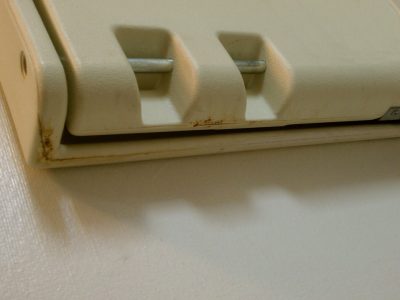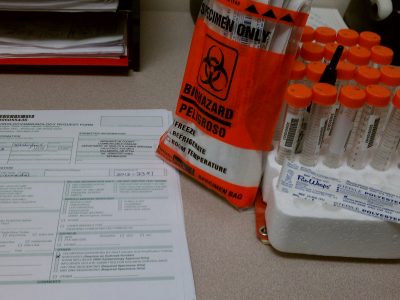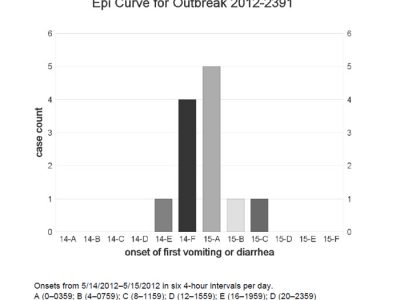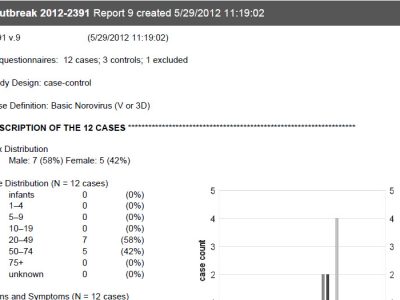| Outbreak: Diaper Changing Station Norovirus | |
|---|---|
| Product: Diaper changing Station | Investigation Start Date: 05/16/2012 |
| Location: Washington County, OR | Etiology: Norovirus |
| Earliest known case onset date: 05/15/2012 | Latest case onset date: 05/15/2012 |
| Confirmed / Presumptive Case Count: 12 / 4 | Positive Environmental Samples: 1 |
| Hospitalizations: 0 | Deaths: 0 |
This outbreak initially appeared to be a standard foodborne point-source outbreak from a restaurant with known previous critical violations. However, upon extensive interviewing, it transpired that a toddler with explosive diarrhea and the associated contaminated surfaces were the source of the outbreak.
- • Outbreak Questionnaire (PDF) | (MS Word)
- • Journal of Infectious Diseases Brief Report: A Norovirus Outbreak Related to Contaminated Surfaces
On May 16, 2012, a local auto dealership called the Washington County (Oregon) Health Department to report a potential foodborne illness outbreak among employees who had attended a staff meeting on May 13. The meeting was held in an open space off the showroom floor. Submarine sandwiches, chips, and condiments from a nearby fast-food restaurant had been provided to attendees.
Environmental health staff conducted an onsite environmental inspection of the restaurant and its operations. Food handlers and restaurant managers reported no recent gastrointestinal illness (within previous 2 weeks) was reported by food handlers or restaurant managers. No other patrons had complained. The restaurant was cited for 2 violations defined by environmental health staff as critical: presence of potentially hazardous food not maintained at proper hot or cold holding temperatures and presence of open beverages on the food preparation table. During interviews with dealership employees, one recalled that a customer with a sick child had used the diaper-changing station in the women’s restroom before the lunch. When the woman and toddler left, the restroom was a mess. The employee cleaned it up as best she could with dry paper towels. She didn’t wear gloves or use bleach but did wash her hands. She left the restroom, opened the dealership’s front door for another employee carrying the food and was the first to take a sandwich from the platter.
Oregon epidemiologists conducted a retrospective cohort study among meeting attendees, using a standard questionnaire to ask about food, environmental exposures, and any history of illness. Cases were defined as meeting attendees who developed vomiting or diarrhea (defined as ≥3 loose stools within a 24-hour period) within 72 hours after the meeting. Environmental health staff evaluated the operations of the restaurant that provided the food, with particular attention to hand washing, food preparation practices, and recent employee illness. Stool specimens were solicited from ill persons and tested for norovirus. Epidemiologists collected environmental samples for norovirus testing from the diaper-changing station at the auto dealership and from a convenience sample of similar diaper-changing stations in public restrooms throughout Washington County.
Stool specimens from 2 employees and the toddler—who was located through auto sales records—were positive for norovirus (genotype GII.6.C) with indistinguishable sequences. According to the mother, the child had been ill for 1 day before the visit to the auto dealership. Although the dealership diaper changing station had reportedly been routinely cleaned twice by a professional janitorial service, using quaternary ammonium disinfectants, we observed brown matter inside and underneath the changing station. Swabs of the brown matter on the changing station were positive for norovirus genotype GII, although the samples did not amplify in viral capsid coding regions C or D, rendering sequencing impossible.
To assess the prevalence of norovirus on diaper-changing stations in Washington County, epidemiologists tested a convenience sample of 14 stations in various restroom locations: 1 restaurant, 3 parks, 3 grocery stores, 1 gas station, 2 shopping malls, 1 aquatic center, 2 libraries, and 1 public health clinic. Eight (57%) of 14 stations had visible brown discoloration on the underside of the fold-down hinge or bed area. All 14 dispensers for disposable bed liners were empty. Norovirus was not detected in swabs of any of the diaper-changing stations other than that the auto dealership.
This outbreak initially appeared as a standard foodborne point-source outbreak from a restaurant with known previous critical violations. However, extensive interviewing revealed that a toddler with explosive diarrhea, and the associated contaminated surfaces, were the source of the outbreak. This outbreak confirms the ability of fomites to transmit norovirus, and the importance of reserving judgment regarding potential foodborne transmission and of considering environmental investigation as a key part of investigating outbreaks of enteric disease.





